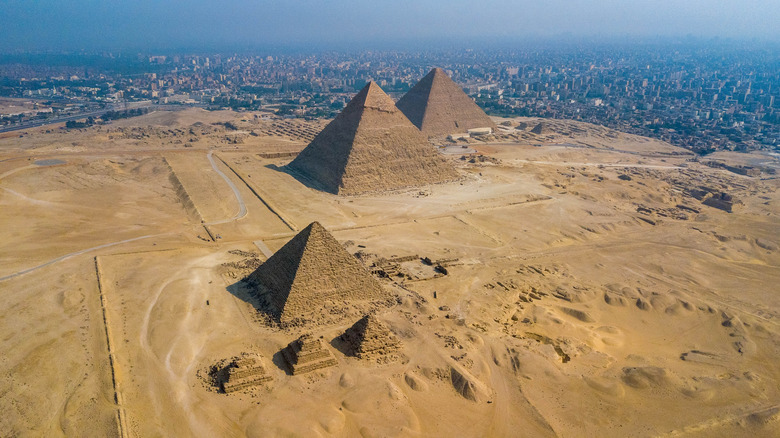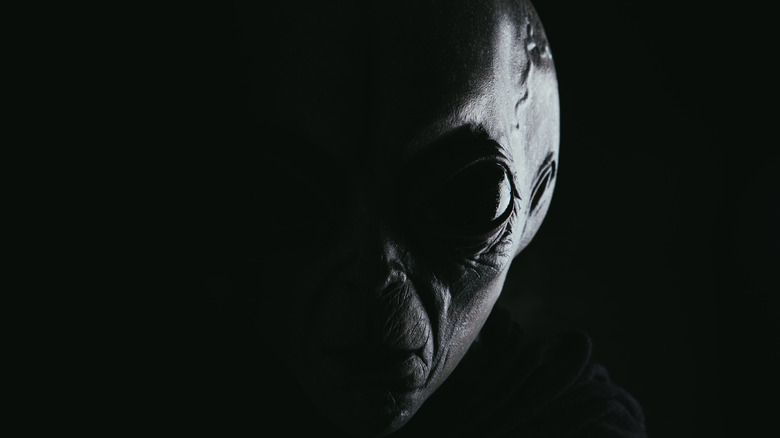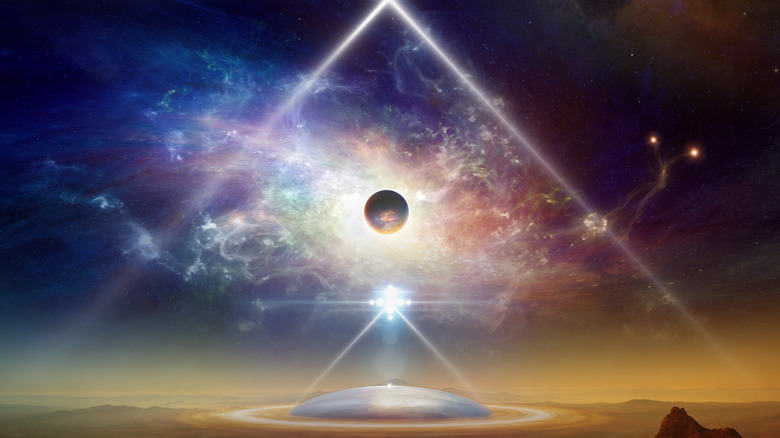This Theory Connects The Egyptian Pyramids To Alien Existence
At this point, many of us might have at least a passing familiarity with what's formally known as the "ancient astronaut theory," especially if we've caught wind of the History channel's "Ancient Aliens" show. The show is ridonkulous but admittedly creative, imagination-inspiring, great with popcorn, and definitely casts doubt on the History channel's name. Plus, in one episode, some spaceships shoot dinosaurs (Season 4, Episode 10, per IMDb). And we've got all those sweet aliens memes vis a vis Mr. "It Was Aliens" himself (and his hair), Giorgio Tsoukalos.
The gist of the ancient astronaut theory is this: Aliens visited humanity in the remote past and dabbled with our genetics, taught us how to make fire, fashion tools, etc. Ancient myths about gods and tricksters are actually tales of literal aliens. So all those sophisticated, awe-inspiring monuments like, say, the Pyramids of Giza? They're just too awesome, so aliens built them, not some "primitive" human louts. The theory — and its vanguard History channel show — rely on a priori reasoning, anecdotal and circumstantial evidence, and embody the adage, "The absence of evidence is not the evidence of absence."
Besides such glaring issues, ancient astronaut theory exudes the rather arrogant assumption that our ancestors were somehow stumbling around the wilderness chewing on rocks just because Steve Jobs hadn't launched the iPhone yet. But let's test things. Who's more ingenious: a survivalist ancestor from 50,000 B.C.E. who scrabbled every day to live using stone axes, or a dude who orders delivery from Uber Eats?
Author Erik von Däniken popularized ancient astronaut theory
So let's have a little fun and dive deeper into the alien-pyramid "theory" (not a theory by any actual scientific or epistemological definition), shall we? The information is vast and as complex as you'd expect from shoelaces strung around tacks stuck into cork boards, so we'll try to keep it streamlined.
Ancient astronaut theory as it relates to the Pyramids at Giza goes back to Swiss author Erik von Däniken, who in 1968 presented his ideas in his book "Chariots of the Gods" (cool title, we admit), as National Geographic points out. Hindu texts like the Vedas, it goes, which describe things like Vimanas — flying chariots navigated by the gods, as Gaia outlines — actually described aerial dogfights using piloted, technological ships. "Gods" and "demons" — separate sides in an alien conflict where Earth was the battleground — fought actual wars with lasers and nuclear weapons and such. They didn't merely inhabit oral tales as symbolic abstractions, and then eventually literature.
Other individuals, like author Zecharia Sitchin, took the ball and ran it further. In particular, he tied these kinds of stories into what is now a popularly spread mythos about Annunaki from the planet Nibiru, who themselves were ancient Sumerian gods like Enlil (a human oppressor figure) and Enki (a human liberator figure). To get a taste of the depth of the rabbit hole, publisher Simon and Schuster has a page for Sitchin's work.
Astronomical alignment on the Giza plateau
Back to the pyramids themselves. Never mind that an alien race who traveled here from another solar system or even galaxy would have crafted architecture and artifacts from metal and circuitry, we assume, not stone to build giant polyhedrons. Proponents of the ancient astronaut theory often point to the host of the pyramid's fascinating astronomical features. More than 4,500 years old, the Pyramids at Giza are thought to be arrayed in a pattern that mirrors the constellation Orion, with three little pyramids for the hunter's belt and some bigger ones for his bow and body, as National Geographic explains. This is known as the Orion Constellation Theory, which was purported by author Robert Bauval in his 1995 book "The Orion Mystery." Per Discover Magazine, Bauval said the pyramids were "created to serve as a gateway to the stars."
The pyramids themselves also uncannily align with the four cardinal directions, north, south, east, and west. Additionally, some researchers have stated that more recently discovered "star shafts" — such as those that lead from the King's Chamber all the way to the surface — also convey astronomical significance. This last part isn't too far-fetched, though, because even The Guardian reports that Egyptians believed their pharaohs traveled to the sky and became undying stars, or "Indestructibles." The problem? None of this has to do with ancient astronaut theory. But, as sites like Gaia illustrate, it's all been vaguely employed in support of fantastical, mystical alien storytelling.
A site of spiritual transformation and literal teleportation
So what do proponents of the alien-pyramid connection say is the purpose of the structures? If aliens built the pyramids, the question is: why? Well (deep breath): they're batteries. That is, as the Daily Express overviews, the pyramids are giant electrical power sources. There's water underneath, something-something-electromagnetism, and presto: the pyramids were power-charging stations for spacecraft. Or they're "interdimensional" portals (second dimension here we come), as an "Ancient Aliens" excerpt on YouTube explains, because of something-something force field. Or, more abstractly (and believably), the pyramids were sites of initiation for a priestly class, not only tombs for pharaohs like Khufu of ancient Egypt's fourth dynasty. Some folks travel to the pyramids to this day seeking such "spiritual transformation," as NBC News cites.
But again: How does such speculation lead to aliens? Just like the Orion Constellation Theory, it doesn't. And yet, folks like Elon Musk have apparently jumped on board the ancient alien astronaut theory, as evidenced by a (perhaps facetious) 2020 tweet. Interestingly, Egyptian Minister of International Cooperation Rania A. Al Mashat sent a polite reply.
Of course, there's an allure to the pyramids that begs for explanation. The grandeur, the scope, the evidence of devotion and labor. Many of us couldn't be bothered to make avocado toast at lunch. What's truly awe-inspiring is what beliefs and powers drove our forbears to follow through on such a seeming-impossible project. Giving credit to aliens is something of an insult, to say the least.



